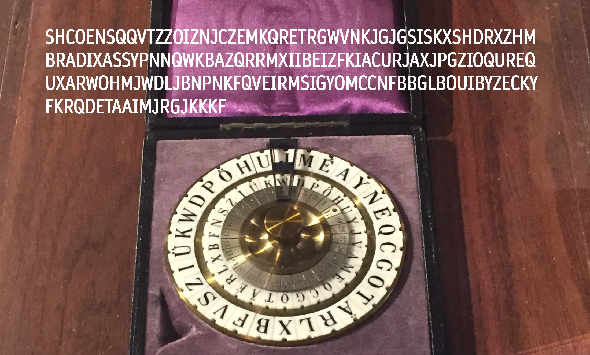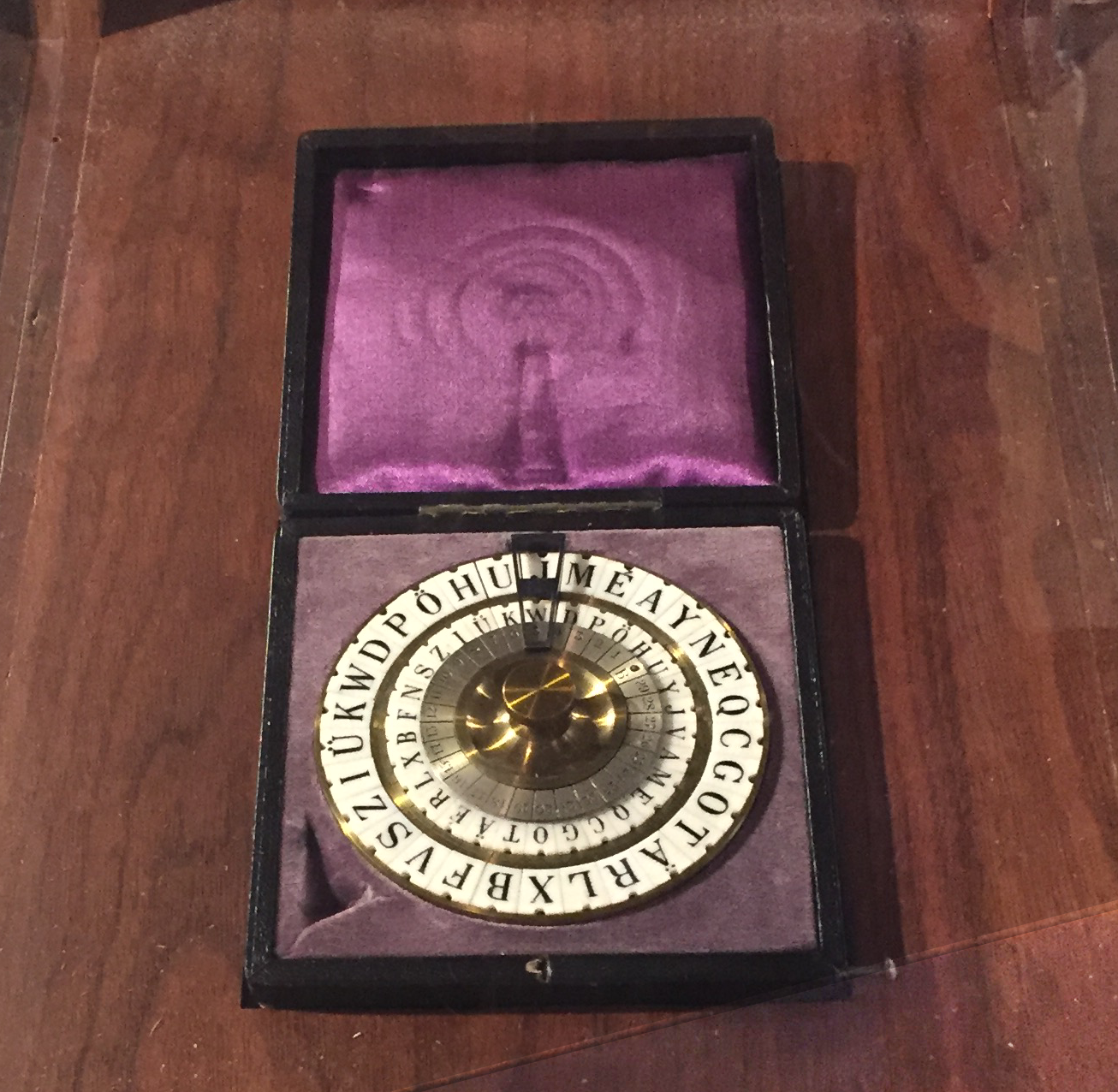Vor drei Monaten hat George Lasry die Challenge von Christoph Tenzer gelöst und ist damit der aktuelle Träger des Friedman-Rings. Heute stelle ich Georges neue Challenge vor. Wer sie löst, wird sein Nachfolger.
English version (translated with DeepL)
Wer das aktuelle Krypto-Rätsel als erstes löst, erstellt das nächste. Nach diesem einfachen Prinzip funktioniert der Friedman-Ring. Dabei handelt es sich um ein Spiel, das nach den Kryptologen William und Elizebeth Friedman benannt ist. Vorbild ist der Iffland-Ring, der bereits seit Jahrhunderten an Schauspieler vergeben wird.
Vor drei Monaten endete die vierte Runde des Friedman-Ring-Spiels. Das bisher letzte Rätsel kam von Christoph Tenzer. George Lasry hat es als erster gelöst und wurde damit der neue Träger des Friedman-Rings.
Damit ergibt sich folgende Liste von Trägern:
- Frank Schwellinger
- Anna Salpingidis und Christoph Tenzer
- Armin Krauß
- Christoph Tenzer
- George Lasry
Es gibt eine Webseite zum bisherigen Verlauf. Der jeweilige Empfänger des Friedman-Rings verpflichtet sich, ein Krypto-Rätsel zu entwickeln und mir zur Verfügung zu stellen. Wer dieses Rätsel als erstes löst, ist der neue Träger.
Die Wheatstone-Scheibe
Heute gibt es die neue Challenge. Dazu möchte ich zunächst kurz erklären, was eine Wheatstone-Scheibe ist. Es handelt sich dabei um ein Verschlüsselungswerkzeug aus dem 19. Jahrhundert:
Eine Weatstone-Scheibe besteht aus zwei konzentrischen Buchstaben-Scheiben. Eine Schablone zeigt oben den Klartext- und unten den Geheimtext-Buchstaben an. Nach dem Verschlüsseln eines Buchstabens wird zum nächsten weitergedreht. Die Anzahl der Buchstaben auf der inneren und der äußeren Scheibe sind unterschiedlich, wodurch sich jeweils eine Verschiebung ergibt.
Schauen wir uns ein Beispiel an, das George mir geschickt hat. Gegeben sei eine Wheatstone-Scheibe mit folgender Aufschrift (die Anzahl der Buchstaben beträgt außen 27, innen 26):
- Plaintext Disk Alphabet: ABCDEFGHIJKLMNOPQRSTUVWXYZ_ – start position: F
- Ciphertext Disk Alphabet: SYPQVTRMXJCNFKZDUIOHEBWALG – start position: C
Wie man sieht, sind die Buchstaben auf der Klartext-Scheibe alphabetisch geordnet, diejenigen auf der Geheimtext-dagegen Scheibe nicht. Der Klartext sei nun folgender: TO_BE_OR_NOT_TO_BE. Georges Software gibt nun folgendes aus (die Positionen der Scheibe beginnen mit 0):
| Plaintext Disk: F ( 5) | Cipher Disk: C (10) Encrypt: T | Moving: 14 Steps | Plaintext Disk: T (19) | Cipher Disk: L (24) | T => L Encrypt: O | Moving: 22 Steps | Plaintext Disk: O (14) | Cipher Disk: E (20) | O => E Encrypt: _ | Moving: 12 Steps | Plaintext Disk: _ (26) | Cipher Disk: R ( 6) | _ => R Encrypt: B | Moving: 2 Steps | Plaintext Disk: B ( 1) | Cipher Disk: X ( 8) | B => X Encrypt: E | Moving: 3 Steps | Plaintext Disk: E ( 4) | Cipher Disk: N (11) | E => N Encrypt: _ | Moving: 22 Steps | Plaintext Disk: _ (26) | Cipher Disk: M ( 7) | _ => M Encrypt: O | Moving: 15 Steps | Plaintext Disk: O (14) | Cipher Disk: W (22) | O => W Encrypt: R | Moving: 3 Steps | Plaintext Disk: R (17) | Cipher Disk: G (25) | R => G Encrypt: _ | Moving: 9 Steps | Plaintext Disk: _ (26) | Cipher Disk: X ( 8) | _ => X Encrypt: N | Moving: 14 Steps | Plaintext Disk: N (13) | Cipher Disk: W (22) | N => W Encrypt: O | Moving: 1 Steps | Plaintext Disk: O (14) | Cipher Disk: A (23) | O => A Encrypt: T | Moving: 5 Steps | Plaintext Disk: T (19) | Cipher Disk: P ( 2) | T => P Encrypt: _ | Moving: 7 Steps | Plaintext Disk: _ (26) | Cipher Disk: J ( 9) | _ => J Encrypt: T | Moving: 20 Steps | Plaintext Disk: T (19) | Cipher Disk: Q ( 3) | T => Q Encrypt: O | Moving: 22 Steps | Plaintext Disk: O (14) | Cipher Disk: G (25) | O => G Encrypt: _ | Moving: 12 Steps | Plaintext Disk: _ (26) | Cipher Disk: N (11) | _ => N Encrypt: B | Moving: 2 Steps | Plaintext Disk: B ( 1) | Cipher Disk: K (13) | B => K Encrypt: E | Moving: 3 Steps | Plaintext Disk: E ( 4) | Cipher Disk: U (16) | E => U
Die verschlüsselte Nachricht lautet also: LERXNMWGXWAPJQGNKU
Schauen wir uns ein weiteres Beispiel an. Dieses Mal habe die Scheibe folgende Aufschrift (die Anzahl der Buchstaben beträgt erneut außen 27, innen 26):
- Plaintext Disk Alphabet: TOJPFGXYZENRUCQKBWMHVID_ALS – start position: G
- Ciphertext Disk Alphabet: SYPQVTRMXJCNFKZDUIOHEBWALG – start position: C
Die Buchstaben sind also auf beiden Scheiben nicht alphabetisch sortiert. Die Software gibt folgendes aus:
| Plaintext Disk: G ( 5) | Cipher Disk: C (10) Encrypt: T | Moving: 22 Steps | Plaintext Disk: T ( 0) | Cipher Disk: R ( 6) | T => R Encrypt: O | Moving: 1 Steps | Plaintext Disk: O ( 1) | Cipher Disk: M ( 7) | O => M Encrypt: _ | Moving: 22 Steps | Plaintext Disk: _ (23) | Cipher Disk: Q ( 3) | _ => Q Encrypt: B | Moving: 20 Steps | Plaintext Disk: B (16) | Cipher Disk: A (23) | B => A Encrypt: E | Moving: 20 Steps | Plaintext Disk: E ( 9) | Cipher Disk: I (17) | E => I Encrypt: _ | Moving: 14 Steps | Plaintext Disk: _ (23) | Cipher Disk: T ( 5) | _ => T Encrypt: O | Moving: 5 Steps | Plaintext Disk: O ( 1) | Cipher Disk: C (10) | O => C Encrypt: R | Moving: 10 Steps | Plaintext Disk: R (11) | Cipher Disk: E (20) | R => E Encrypt: _ | Moving: 12 Steps | Plaintext Disk: _ (23) | Cipher Disk: R ( 6) | _ => R Encrypt: N | Moving: 14 Steps | Plaintext Disk: N (10) | Cipher Disk: E (20) | N => E Encrypt: O | Moving: 18 Steps | Plaintext Disk: O ( 1) | Cipher Disk: F (12) | O => F Encrypt: T | Moving: 26 Steps | Plaintext Disk: T ( 0) | Cipher Disk: F (12) | T => F Encrypt: _ | Moving: 23 Steps | Plaintext Disk: _ (23) | Cipher Disk: J ( 9) | _ => J Encrypt: T | Moving: 4 Steps | Plaintext Disk: T ( 0) | Cipher Disk: K (13) | T => K Encrypt: O | Moving: 1 Steps | Plaintext Disk: O ( 1) | Cipher Disk: Z (14) | O => Z Encrypt: _ | Moving: 22 Steps | Plaintext Disk: _ (23) | Cipher Disk: C (10) | _ => C Encrypt: B | Moving: 20 Steps | Plaintext Disk: B (16) | Cipher Disk: V ( 4) | B => V Encrypt: E | Moving: 20 Steps | Plaintext Disk: E ( 9) | Cipher Disk: L (24) | E => L
Dieses Mal lautet der verschlüsselte Text: RMQAITCEREFFJKZCVL.
Für alle, die mehr wissen wollen, hat mir George folgende Links geschickt:
- Buch von Willam Friedman mit einem Kapitel über die Wheatstone-Scheibe (S. 187)
- Buch von Lambros Callimahos mit einem Kapitel (Chapter VIII) über die Wheatstone-Scheibe
- Challenge auf MysteryTwister mit einer sortierten (Klartext) und einer unsortierten (Geheimtext) Aufschrift, wie im ersten Beispiel
George Lasrys Kryptogramm
Georges Friedman-Ring-Challenge wurde mit einer Wheatstone-Scheibe verschlüsselt, bei der beide Buchstaben-Ringe nicht alphabetisch geordnet sind. Die Anzahl der Buchstaben beträgt außen 27, innen 26. Hier ist der verschlüsselte Text:
SHCOE NSQQV TZZOI ZNJCZ EMKQR
ETRGW VNKJG JGSIS KXSHD RXZHM
BRADI XASSY PNNQW KBAZQ RRMXI
IBEIZ FKIAC URJAX JPGZI OQURE
QUXAR WOHMJ WDLJB NPNKF QVEIR
MSIGY OMCCN FBBGL BOUIB YZECK
YFKRQ DETAA IMJRG JKKKF
Findet ein Leser die Lösung? Der Friedman-Ring wartet schon darauf, von George an den nächsten Leser übergeben zu werden.
Zugegebenermaßen wäre ich nicht auf die Idee gekommen, eine Challenge auf Basis der Wheatstone-Scheibe zu erstellen, denn eigentlich gilt dieses Verschlüsselungswerkzeug als unsicher. Wenn man allerdings die Reihenfolge der Buchstaben nicht kennt, wird es schwierig. Ich bin daher gespannt, ob ein Leser die Chiffrierung knackt. Hill Climbing, der Super-Algorithmus des Codeknackens, dürfte hier nicht ohne Weiteres funktionieren.
Wie schon öfters erwähnt, gehört es zu den Nachteilen einer solchen Challenge, dass jeder Leserhinweis, der als Kommentar veröffentlicht wird, einem anderen Codeknacker zum Gewinn verhelfen kann. Ich bitte mein Leser daher, nicht ganz so egoistisch zu sein. Wenn im Forum über Lösungswege diskutiert wird, macht das die Sache für alle spannender. Natürlich werde ich jeden Kommentar, der zur Lösung beigetragen hat, entsprechend würdigen.
Das Rennen ist eröffnet!
Follow @KlausSchmeh
Further reading: Christoph’s Chaotic Caesar Challenge
Linkedin: https://www.linkedin.com/groups/13501820
Facebook: https://www.facebook.com/groups/763282653806483/





Kommentare (63)